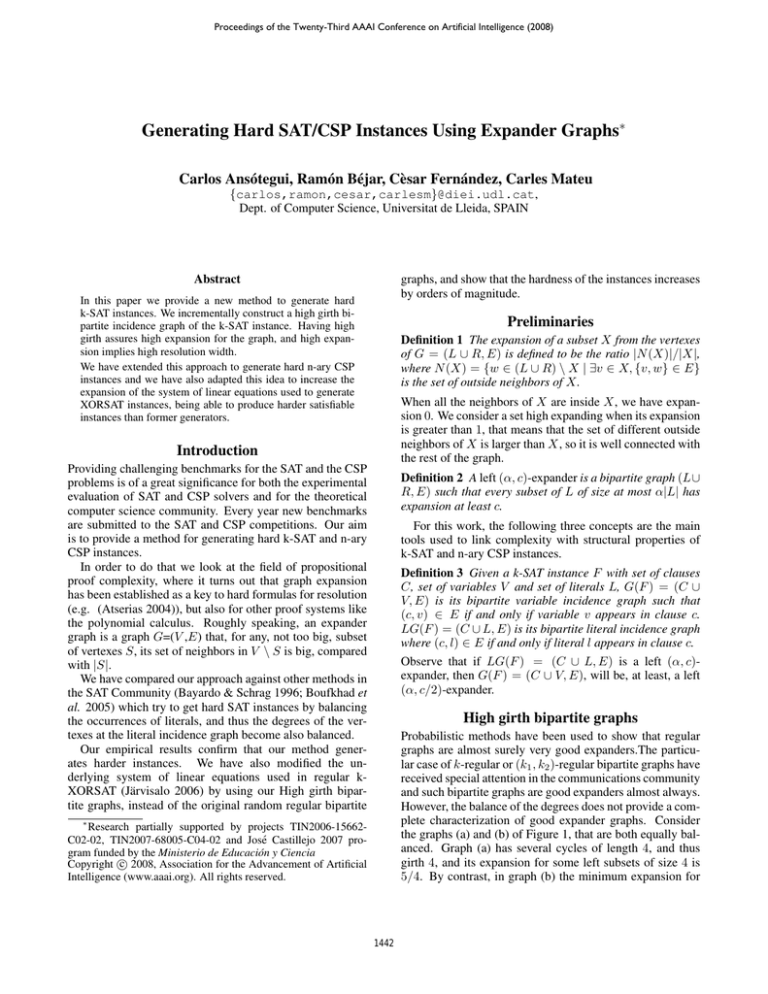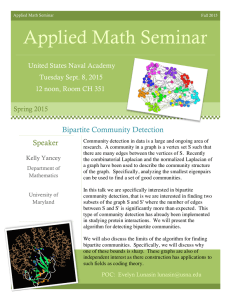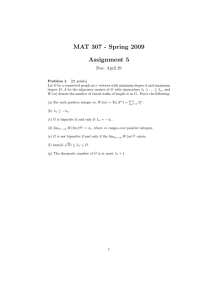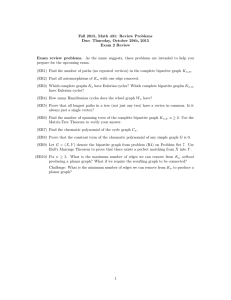
Proceedings of the Twenty-Third AAAI Conference on Artificial Intelligence (2008)
Generating Hard SAT/CSP Instances Using Expander Graphs∗
Carlos Ansótegui, Ramón Béjar, Cèsar Fernández, Carles Mateu
{carlos,ramon,cesar,carlesm}@diei.udl.cat,
Dept. of Computer Science, Universitat de Lleida, SPAIN
Abstract
graphs, and show that the hardness of the instances increases
by orders of magnitude.
In this paper we provide a new method to generate hard
k-SAT instances. We incrementally construct a high girth bipartite incidence graph of the k-SAT instance. Having high
girth assures high expansion for the graph, and high expansion implies high resolution width.
We have extended this approach to generate hard n-ary CSP
instances and we have also adapted this idea to increase the
expansion of the system of linear equations used to generate
XORSAT instances, being able to produce harder satisfiable
instances than former generators.
Preliminaries
Definition 1 The expansion of a subset X from the vertexes
of G = (L ∪ R, E) is defined to be the ratio |N (X)|/|X|,
where N (X) = {w ∈ (L ∪ R) \ X | ∃v ∈ X, {v, w} ∈ E}
is the set of outside neighbors of X.
When all the neighbors of X are inside X, we have expansion 0. We consider a set high expanding when its expansion
is greater than 1, that means that the set of different outside
neighbors of X is larger than X, so it is well connected with
the rest of the graph.
Introduction
Providing challenging benchmarks for the SAT and the CSP
problems is of a great significance for both the experimental
evaluation of SAT and CSP solvers and for the theoretical
computer science community. Every year new benchmarks
are submitted to the SAT and CSP competitions. Our aim
is to provide a method for generating hard k-SAT and n-ary
CSP instances.
In order to do that we look at the field of propositional
proof complexity, where it turns out that graph expansion
has been established as a key to hard formulas for resolution
(e.g. (Atserias 2004)), but also for other proof systems like
the polynomial calculus. Roughly speaking, an expander
graph is a graph G=(V ,E) that, for any, not too big, subset
of vertexes S, its set of neighbors in V \ S is big, compared
with |S|.
We have compared our approach against other methods in
the SAT Community (Bayardo & Schrag 1996; Boufkhad et
al. 2005) which try to get hard SAT instances by balancing
the occurrences of literals, and thus the degrees of the vertexes at the literal incidence graph become also balanced.
Our empirical results confirm that our method generates harder instances. We have also modified the underlying system of linear equations used in regular kXORSAT (Järvisalo 2006) by using our High girth bipartite graphs, instead of the original random regular bipartite
Definition 2 A left (α, c)-expander is a bipartite graph (L∪
R, E) such that every subset of L of size at most α|L| has
expansion at least c.
For this work, the following three concepts are the main
tools used to link complexity with structural properties of
k-SAT and n-ary CSP instances.
Definition 3 Given a k-SAT instance F with set of clauses
C, set of variables V and set of literals L, G(F ) = (C ∪
V, E) is its bipartite variable incidence graph such that
(c, v) ∈ E if and only if variable v appears in clause c.
LG(F ) = (C ∪ L, E) is its bipartite literal incidence graph
where (c, l) ∈ E if and only if literal l appears in clause c.
Observe that if LG(F ) = (C ∪ L, E) is a left (α, c)expander, then G(F ) = (C ∪ V, E), will be, at least, a left
(α, c/2)-expander.
High girth bipartite graphs
Probabilistic methods have been used to show that regular
graphs are almost surely very good expanders.The particular case of k-regular or (k1 , k2 )-regular bipartite graphs have
received special attention in the communications community
and such bipartite graphs are good expanders almost always.
However, the balance of the degrees does not provide a complete characterization of good expander graphs. Consider
the graphs (a) and (b) of Figure 1, that are both equally balanced. Graph (a) has several cycles of length 4, and thus
girth 4, and its expansion for some left subsets of size 4 is
5/4. By contrast, in graph (b) the minimum expansion for
∗
Research partially supported by projects TIN2006-15662C02-02, TIN2007-68005-C04-02 and José Castillejo 2007 program funded by the Ministerio de Educación y Ciencia
c 2008, Association for the Advancement of Artificial
Copyright Intelligence (www.aaai.org). All rights reserved.
1442
1
2
3
4
5
6
7
8
1
2
3
4
5
6
7
8
(a) (3, 3)-regular
1
2
3
4
5
6
7
8
1
2
3
4
5
6
7
8
Algorithm 1: Algorithm for generation of High girth (k, −)regular bipartite graphs (V1 ∪ V2 , E)
input : V1 , V2 , k
output: bipartite (k, −)-regular graph (V1 ∪ V2 , E)
Initialize E with a random matching from V1 to V2
(every vertex from V1 will have degree 1)
for i = |V1 | + 1 to k|V1 | do
LT := {u ∈ V1 | degree(u) < k}
RT := {u ∈ V2 | degree(u) ≤ degree(v), ∀v ∈ V2 }
maxdist := 1
while (maxdist = 1) do
T := {(u, v) | (u, v) ∈ LT × RT dist(u, v) ≥
dist(x, y)∀(x, y) ∈ LT × RT }
dmin := degree(u), where u ∈ RT
maxdist := dist(u, v), where (u, v) ∈ T
if (maxdist = 1) then
RT := {u ∈ V2 | degree(u) = dmin + 1}
(b) (3, 3)-regular
Figure 1: Bipartite graphs with same balance and different
expansion
Table 1: Median time (seconds) for satisfiable 3-SAT, 4-SAT
and 5-SAT with High girth, regular XORSAT (⊕-sat) and
with High girth-XORSAT (HG-⊕sat) (* denotes more than
2 · 104 s.)
Num. vars
High girth
⊕-sat
HG-⊕sat
200
0
14
642
Num. vars
High girth
⊕-sat
HG-⊕sat
100
3
4
66
E := E ∪ (u, v), where (u, v) ∈ T
3-SAT
250
270
300 330
350
7
14
91 368 1125
386 2322 19778
*
*
*
*
*
*
*
4-SAT
5-SAT
130
150
80
90
100
59 1180
64
405 2839
201 2543
51
290 2528
8018
* 586 3186
*
Table 2: Ratio of median time on peak of hardness
3-SAT
4-SAT
5-SAT
Num. vars. 300 330 130 150
70
100
HG/Lit
1.29 1.44 1.34 1.39 1.64 3.09
80.2 132 4.58 5.59 1.73 2.09
Lit/Ran
higher arity (k) is, the higher the ratio HG/Lit results, particularly for larger number of variables. The ratio Lit/Ran
seems to decrease. As we increase k, more variables may
be needed in order to observe a difference. The XORSAT
instances are harder than satisfiable ones from High girth,
but generating the system of linear equations for k-XORSAT
with our High girth method (HG-XORSAT) we obtain the
hardest instances (see Table 1).
For n-ary CSPs, we have obtained similar results when
generating their literal incidence graph with our High girth
algorithm. For example, for instances with |V | = 25, |D| =
3 and arity 4, our High girth based CSP instances are about
1 order of magnitude harder to solve than random CSP instances.
left subsets of size 4 is 7/4. The main structural difference
with the graph (a) is actually its girth, that in this case is 6.
For building the literal incidence graph of a k-SAT formula with C clauses and L literals (and similarly for a k-ary
CSP formula), we need to build a (k, −)-regular bipartite
graph (C ∪ L, E). Algorithm 1 does this, but trying to keep
the girth as high as possible, using the technique of linking
vertexes which are at large distances in the current graph.
It starts the process by creating a random matching from C
to L, such that every vertex from C will have degree 1 and
every vertex from L will have degree either b|C|/|L|c or
b|C|/|L|c + 1. Because this matching does not create any
cycles, it starts with girth equal to ∞. Then, at every step it
selects an edge from the subset of edges (u, v) with u ∈ C
and v ∈ L, such that degree(u) < k and degree(v) is minimum among all the current degrees in L. From this subset
of edges, it selects one (u0 , v 0 ) with the maximum distance
between u0 and v 0 , because this way the new created cycle is
of maximum length.
References
Atserias, A. 2004. On sufficient conditions for unsatisfiability of random formulas. Journal of the ACM 51(2):281–
311.
Bayardo, R., and Schrag, R. 1996. Using CSP look-back
techniques to solve exceptionally hard sat instances. In
Principles and Practice of Constraint Programming - CP
1996, 46–60.
Boufkhad, Y.; Dubois, O.; Interian, Y.; and Selman, B.
2005. Regular random k-sat: Properties of balanced formulas. Journal of Automated Reasoning 35(1-3):181–200.
Järvisalo, M. 2006. Further investigations into regular xorsat. In Proceedings of the AAAI 2006,. AAAI Press / The
MIT Press.
Experimental investigation
For generating k-SAT instances we used five methods:
classical random k-SAT (Random), (Bayardo & Schrag
1996)(Lit-bal-1), (Boufkhad et al. 2005)(Lit-bal-2), regular
k-XORSAT and ours (High girth). Lit-bal-1 and Lit-bal-2
were almost identical. Best SAT solver among minisat, kcnfs, and satz used at every data point. Table 2 shows the
1443







